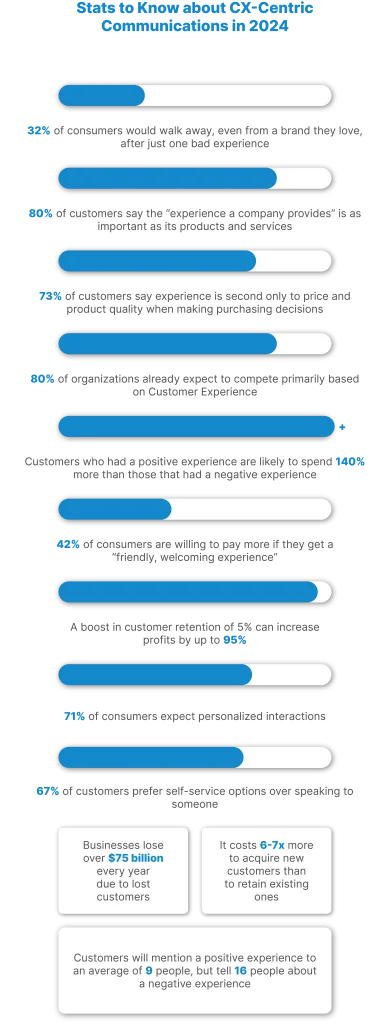Customer Experience 101
What is Customer Experience?
When we discuss Customer Experience (CX), we are going beyond customer service and support, expanding to the entire interaction and perception that customers have with a brand or company, encompassing every touchpoint and interaction, during the customer journey.
A positive customer experience will involve excellent communication, clear value in every interaction, and, of utmost importance, efficient resolution. The customer has a goal to reach, and the way they feel on the way to resolving that goal is the customer experience.
Who is Looking for Customer Experience Initiatives?
In short, everyone. On the customer side of the equation, the demand for a positive customer experience is evident. Consumers today have access to many choices and are not willing to put up with negative experiences. According to a study done by PwC, 32% of consumers would walk away, even from a brand they love, after just one bad experience.
Customer expectations are higher than ever too, with consumers wanting businesses to meet them where they are for convenient, effortless interactions. According to a survey done by Salesforce, 80% of customers say the “experience a company provides” is as important as its products and services.
The PwC study agrees, finding that 73% of customers say experience is second only to price and product quality when making purchasing decisions.
Given the high consumer demand for a positive experience, products and solutions that support businesses in delivering positive customer experiences are in high demand as well. A study from Gartner found that 80% of organizations already expect to compete primarily based on Customer Experience.
Why are Businesses Investing in CX?
In addition to the obvious desire to keep customers happy, businesses are discovering other motivators to invest in a CX-centric approach. These are things that drive your customers and end users to spend on solutions that support the customer experience.
‣ Financial stability
Analysis of the financial crisis of 2008 done by McKinsey found that “customer experience leaders saw a shallower downturn, rebounded more rapidly, and achieved three times the total shareholder returns in the long run compared with the market average.” The focus on customer-centricity correlates with a more financially-stable business that can withstand downturns and challenges.
‣ More Revenue
When customers are happy, they spend more, increasing revenue. Research from Deloitte found that customers who had a positive experience are likely to spend 140% more than those that had a negative experience. And PwC found that 42% of consumers are willing to pay more if they get a “friendly, welcoming experience”.
‣ Customer Loyalty
Decreasing customer churn is so important to the bottom line. According to research from Zippia, businesses lose over $75 billion every year due to lost customers, and it costs six to seven times more to acquire new customers than to retain existing ones. The good news is that even a tiny boost in customer retention of 5% can increase profits by up to 95%. The investment in CX to improve customer loyalty is clearly worth it.
‣ Brand image and reputation
Customers are the best source of marketing. A peer recommendation carries far more weight than any marketing email or advertisement, so improving customer loyalty is good for business. In fact, the research from Deloitte finds that customers will mention a positive experience to an average of 9 people, but tell 16 people about a negative experience. What customers are saying matters.

The Importance of Communications in CX
The evidence is indisputable: CX is relevant, in high demand, and organizations are motivated to adopt new solutions and strategies to support it. What does this have to do with communications solutions like your own? Well, everything.
In rating what elements matter to a positive customer experience, speed, convenience, knowledgeable help, and friendly service came out on top, according to the research from PwC.
What do these four have in common? Communication. Speed of service can only be delivered via rapid, efficient communication. Convenience means meeting the customer where they are at with flexible communication channels. Knowledgeable help and friendly service are achieved by empowering employees with communication tools that give them access to knowledge, resources, and support while interacting with customers.
This is your opportunity to tailor your products and services to prioritize customer experience and meet the market demand for CX-centric communications solutions.
Key Components of CX-Centric Communications
In order to prioritize the customer experience, your communications solutions should include some basic components. Based on research from all of our previously cited sources, plus experience with our own partners and distributors, we have identified several pillars of CX-centric communications:
‣ Personalization and empathy
The key to positive customer experiences that emerges time and again is personalization. McKinsey & Company found that 71% of consumers expect personalized interactions.
CRM integration incorporates a record of all customer interactions and details right into the communications solution to empower representatives to instantly access and utilize those personal details when interacting with a customer.
‣ Convenience and speed of service
Instant gratification – it has become an expectation that permeates all industries and markets. Customers today expect immediate attention and resolution.
Chatbots, smart routing, and omnichannel are a few tools that enable organizations to become more responsive and available. These open more channels of communication and connect customers with the right person more quickly.
‣ Options for self-service
In a world saturated with technology and Artificial Intelligence, consumers expect to be able to make purchases and resolve issues without human interaction.
According to Zendesk, 67% of customers prefer self-service options over speaking to someone. Interactive Voice Response (IVR) and chatbots are two examples of self-service communication tools.
‣ Proactive communication
Waiting until problems arise to interact with customers is a surefire way to provoke a negative customer experience. Proactive communication involves reaching out to customers to check in before problems pop up and escalate.
Unified communications apps make consistent communication easy with instant messaging for quick chats and recurring meetings that force consistent check-ins.
‣ Centralized technology
Having too many tools and types of technology leads to problems like data silos and disruptions to the customer experience.
Research from Salesforce found that “79% of customers expect consistent interactions across departments,” but 56% find this is not happening and they have to repeat and re-explain as they get passed around the company.
Unified communications and cloud computing synergize all of the tools into one simplified interface that keeps customer interactions and data organized and easily accessible throughout the customer journey.
‣ Customer feedback
In addition to being wildly important to growing and developing a business, gathering feedback makes customers feel heard and valued. Omnichannel tools make it easier through automations and organization.
Customers can leave feedback through a survey at the end of a phone call, on social media, or via a web form. Managers can access and analyze this feedback in a centralized location.
CX-Centric Communications Solutions
Now you know what the market is looking for in terms of CX-centric communications solutions, so let’s take a look at a few of the actual products that can power these solutions.
Contact Center
The term “contact center” may conjure images of an unending row of cubicles with representatives answering calls robotically, but the contact center landscape has changed significantly. Today, any business or organization with customers (and nearly all businesses have customers!) would benefit from a contact center solution.
Contact Center as a Service (CCaaS) places dynamic and powerful tools at the fingertips of anyone interacting with customers to support a more positive customer experience.
Things like Interactive Voice Response (IVR), smarter call routing and queues, and automatic dialers help make customer interactions more personal, efficiency, and positive.
Learn more in our article All You Need To Know About Contact Center as a Solution.
Omnichannel
Going one stop further, an omnichannel-enabled contact center solution is the real game changer. According to research from Adobe, companies employing omnichannel engagement strategies experience 10% year-on-year growth, a 10% increase in the average purchase value, and a 25% increase in close rates.
With numbers like these, it is no wonder that the number of companies investing in omnichannel has grown from 20% to more than 80% since 2020 (PwC).
Omnichannel solutions open more channels of communications, like SMS and live chat, to give customers more opportunities to connect. Smart queues and auto-assignment technology help customers reach a resolution more quickly and with fewer disruptions.
Read more in our article Omnichannel: How Contact Center Mastered This Strategy
Conclusion
As a communications solutions provider, you hold the keys to unlocking customer-centricity and achieving a more positive customer experience for business growth and success. The market is looking for solutions, starting with your existing customers who are likely already looking for ways to focus on CX.
Start tailoring your solution today with unified communications and omnichannel contact center solutions to meet customer demand and find your competitive edge.

